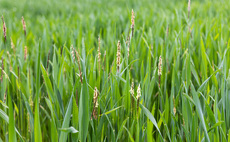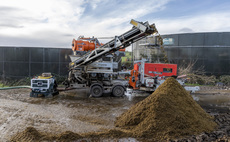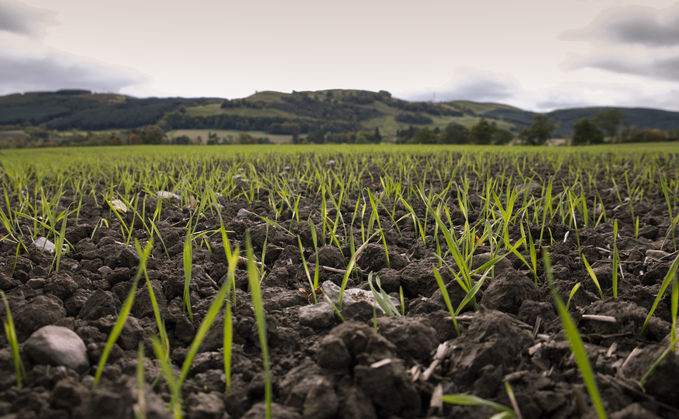
"Following a notably wet year, ensuring effective residual herbicide application and maximising their longevity in the weed germination zone, is vital for achieving a strong weed-free start to the growing season," advises Stuart Sutherland, technical manager at Interagro.����
"Pre-emergence herbicide programmes represent a critical element of effective weed management strategies, reducing reliance on less effective contact herbicides post-emergence. But with the performance of soil-acting residual herbicides highly dependent on good soil structure, and favourable weather conditions following application, weed control strategies could be under serious pressure if farmers fail to take action when conditions take a turn for the worst," says Stuart.��
��
Key strategies for pre-emergence herbicide success��
"To maximise the performance of pre-emergence herbicides this autumn, we would encourage farmers to focus on five key areas to get the most from their pre- and peri-emergence herbicides," he advises:��
��
1. PREPARE THE SOIL WELL
The foundation of effective soil-acting residual herbicide application and efficacy, lies in good soil structure. Assess soils before drilling and improve soil conditions where necessary by:
- Ensuring good tilth: A well-structured soil, free from any surface crust, promotes even distribution of herbicides across the surface.
- Addressing compaction:��Removing compacted layers allows for better water and herbicide infiltration, ensuring that active ingredients reach the weed germination zone.
- Enhancing porosity:��Healthy porous soils retain moisture better, supporting crop growth and herbicide efficacy.
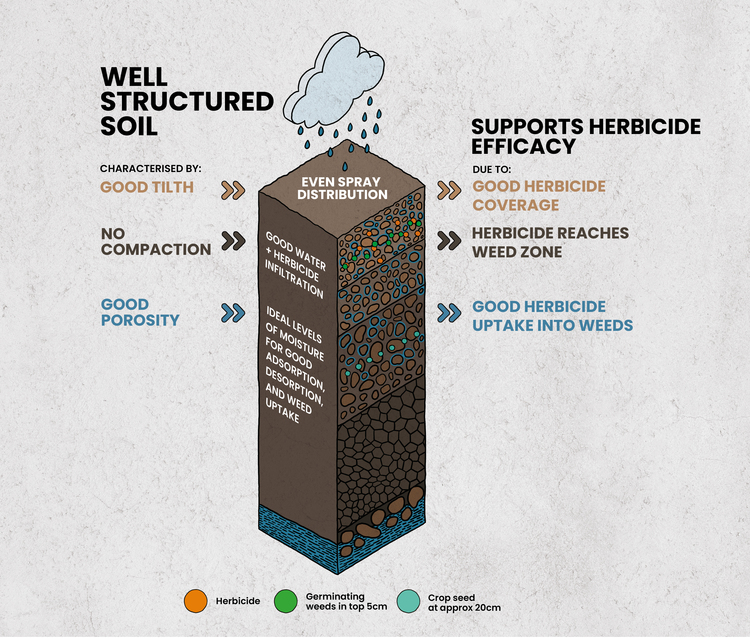
��
2. MONITOR SOIL MOISTURE
Adequate soil moisture levels play a critical role in the activation and performance of residual herbicides. Ensure that sufficient moisture is present after application:
- Residual herbicide activation: Requires moisture to move herbicides from the soil surface to the weed germination zone 5cm lower down.
- Herbicide uptake into weeds: Dependent on good moisture levels for efficient desorption from soil particles.
- Consider delaying pre-ems in a dry spell: Especially if there is insufficient moisture for weeds to germinate shortly after application.
��
3. AVOID HEAVY RAINFALL IMMEDIATELY AFTER APPLICATION
Schedule pre- and peri-emergence applications when rain is forecast but avoid periods of heavy rain shortly after spraying to ensure herbicides have sufficient time to bind to soil particles, particularly in light soils:
- Herbicide retention in the weed zone: This is crucial to ensure ongoing control of germinating weeds. Steer clear of heavy rainfall shortly after application to avoid herbicides being washed out of the weed zone, resulting in a sub-lethal dose and reduced residual activity.
- Crop and groundwater safety: Can be at risk in adversely wet conditions if herbicides are washed prematurely from the weed zone. Stay informed about local weather conditions and adjust your application timing accordingly.
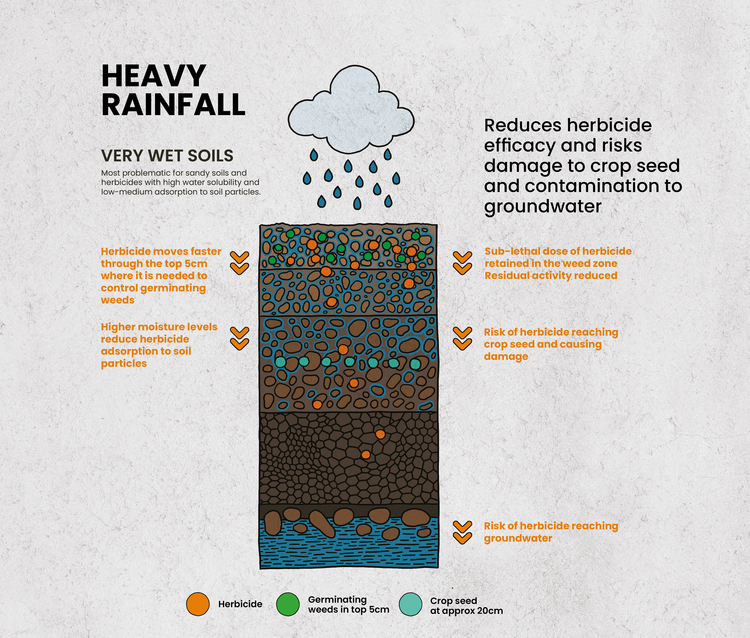
��
4. APPLY ON CALM DAYS
Choose days with low wind speeds to minimise drift and ensure even herbicide application across the soil target:
- Even spray coverage: An even spray coverage is crucial to create an effective barrier against weed emergence.
��
5. INCORPORATE ADJUVANT BACKROW MAX
Backrow Max is a proven adjuvant that enhances the performance of pre-emergence herbicides, providing multiple benefits:
- Improved moisture retention: Backrow Max helps maintain soil moisture levels, reducing reliance on rainfall for herbicide activation and promoting consistent uptake by germinating weeds.
- Enhanced binding: It improves the binding of herbicides to soil particles, prolonging their concentration in the weed germination zone and enhancing effectiveness in wet conditions.
- Drift minimisation and improved deposition: Backrow Max reduces the number of fine droplets susceptible to drift and the number of very coarse droplets prone to bounce, resulting in more uniform distribution across the soil surface and a stronger barrier to weed emergence.
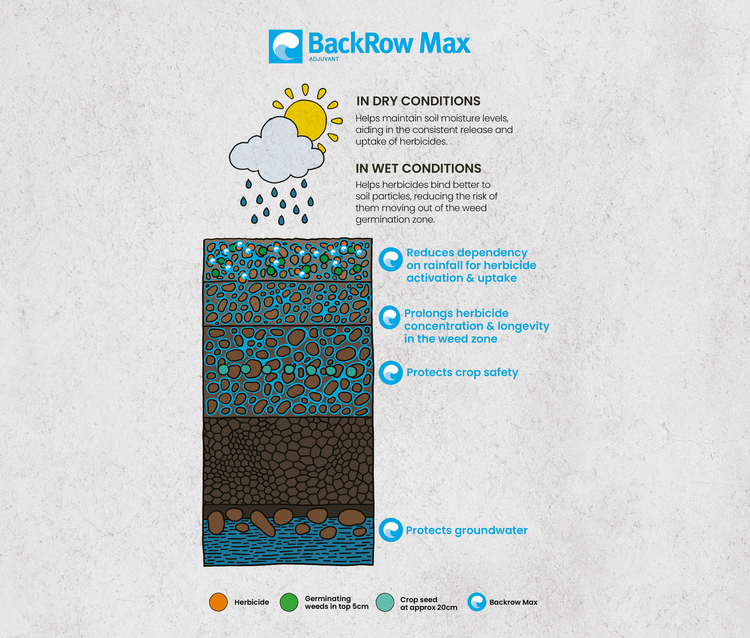
��
PROVEN RESULTS WITH BACKROW MAX
Farmers using Backrow Max can expect significant improvements in herbicide performance in suboptimal conditions, including:
- Increased herbicide retention: Studies at the Institute of Soil Science and Plant Cultivation in Poland showed enhanced retention in the top 5cm of soil with all herbicides tested: 7% more clomazone; 8% more pendimethalin; 6% more Luximo.
- Enhanced residual activity: In replicated field trials valuable weed control benefits have been achieved by increasing herbicide retention. In cereals up to: +17% black-grass control; +17% ryegrass control; +18% brome control.
- Enhanced moisture retention: Backrow Max has demonstrated a 33% increase in water retention - recorded in Lysimeter studies in the Netherlands - crucial for maintaining herbicide efficacy in dry seedbeds.
- Improved effectiveness in dry seedbeds: In cereals up to: +22% black-grass control; +18% annual meadow-grass control.
- Reduced crop phytotoxicity: The use of Backrow Max minimises the risk of herbicide damage to crops, supporting better establishment and growth. In trials: 20% reduction in chlorosis and increased wheat emergence by up to 29 plants per sqm.
As the weather deteriorates on farm, leveraging the power of Backrow Max alongside both pre- and peri-emergence herbicides can lead to superior weed management and crop establishment. By focusing on soil health, monitoring the weather and utilising an effective adjuvant, farmers can secure a robust start to the season.
��

Download our latest guide
For more information on Backrow Max and how to optimise your pre-emergence herbicide strategy, please download our latest guide below.
��
This post is funded by Interagro.








